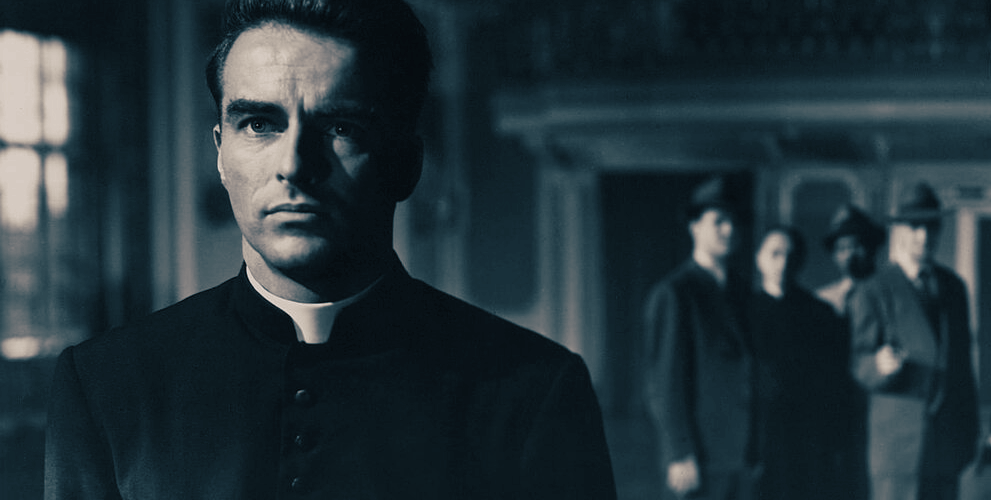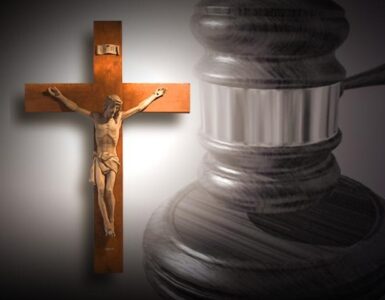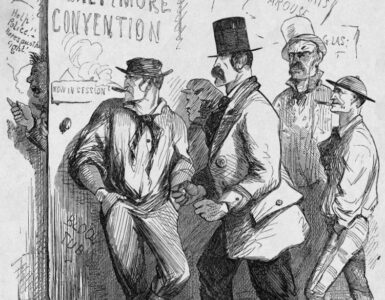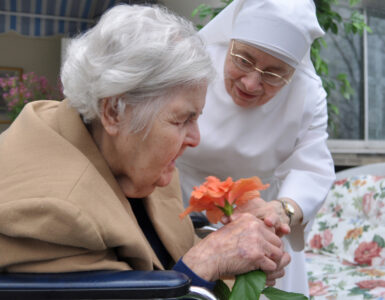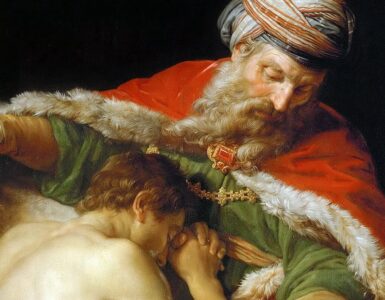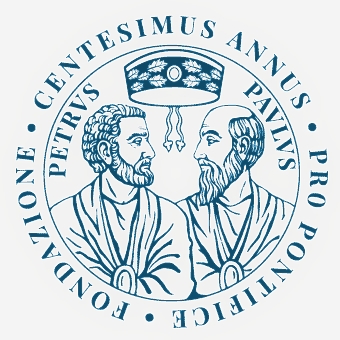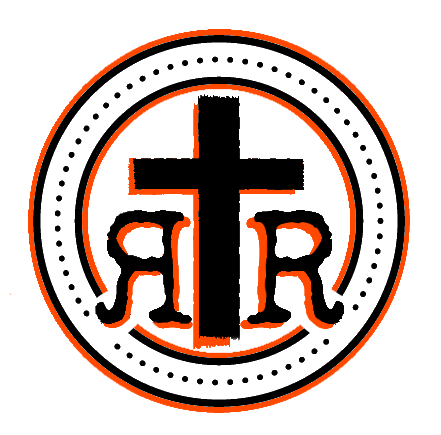I made my first Confession approximately 75 years ago at Our Lady Queen of Martyrs in Forest Hills, New York. I do not remember too much about that one. In those days they urged us to go more frequently. The Church was caught in a more legalistic mode of thought when I was young.
The very idea of confessing my sins to an adult was a frightening experience. There just seemed to be so many sins that even a young boy could fall prey to. It seemed as if sin was everywhere. Often, I did not know how or what to say which created a great anxiety even then. One priest was known to threaten his young penitents with eternal damnation if we even stumbled during our confession.
I entered the more merciful church of Vatican II, grew and the Church emphasized positive things much of my anxiety lessened. I personally liked it when we could confess face to face. Sin did not seem so prevalent as it did in the legalistic Church of my youth. (See my 2015 essay, Two Churches)
This is in stark contrast to the 21st century when one would almost think that people don’t believe we are capable of seriously sinning. This could explain why Church attendance and reception of the sacraments, especially among the young, have declined over the years.
I cannot remember when I actually learned about the Seal of Confession, whose breech is probably the worst sin a priest can ever commit. It carries with it the penalties of immediate excommunication and removal of all priestly faculties. It doesn’t matter if priests were tortured, imprisoned or exiled, they still could not tell the sins of anyone who had confessed to them.
The Seal of Confession was established in 1215 at the Fourth Council of the Lateran and was binding on the universal Church. I read a fascinating essay in Catholic Exchange, written by a Father Kevin Drew, entitled, Behold the Heart of a Traitor: Breaking the Seal of Confession. Father Drew tells the story of the Catholic Church during the aftermath of King Henry VIII’s schism with the Catholic Church because Pope Clement VII would not let him divorce his wife, Catherine of Aragon because she could not produce a son to carry on his family line.
Unfortunately, this initiated the English Reformation, separating the Church of England from papal authority. Henry appointed himself the Supreme Head of the Church of England and dissolved monasteries and convents. The pope promptly excommunicated him. In 1534, England’s Parliament took absolute control of religion. England had been Catholic for 900 years. Priests were given three choices. Acknowledge King Henry VIII, as the supreme head of the Church of England, leave the country or be hunted down and killed. Many suffered the third choice.
Many Catholics, who remained were quickly disillusioned with Protestant rule and its subsequent persecutions. As a result, they dispensed with peaceful protests. Around midnight on November 4, 1605, a man named Guy Fawkes was arrested in the House of Lords. He was found guarding 36 barrels of gunpowder. The plan was to blow the building up and with it the king and all the members of Parliament.
In 1606, a Jesuit priest, Henry Garnet was arrested for his fore-knowledge of this treacherous plot, in what is known to history as the Gunpowder Plot. He had garnered his knowledge from the confession of one of the conspirators. Yet he would not nor could not tell the authorities who had confessed. He was not protecting the conspirators, whose plot sickened him, but the seal of confession.
For this, Father Garnet, suffered the English punishment of being hung, drawn and quartered in London in front of a roaring crowd. This barbaric punishment was graphically dramatized in the Mel Gibson movie, Braveheart about the legendary Scottish hero, William Wallace. Father Garnett’s nephew, also a priest and all the other conspirators were executed in the same manner for their treason and their Catholic faith.
Father Drew’s essay also mentioned an old Montgomery Clift film, I Confess. Directed and produced by the master himself, Alfred Hitchcock, it details the trials of a Catholic priest, played by Clift. Father Logan is a devout Catholic priest in Ste. Marie’s Church in Quebec City, where it was beautifully filmed in black and white. The priest employed a German couple, namely Otto and Alma Keller as caretaker and housekeeper. Otto also worked as a gardener for the lawyer Villette.
Based on a 1902 play, Nos Deux Consciences by Paul Anthelme, (Our Two Consciences), the film begins with a man wearing a priest’s cassock emerging from Villette’s home with the lawyer dead on the floor. He proceeds to the church where he confesses his grievous sin to Father Logan that he had just killed the shady lawyer. He says he accidentally killed him while trying to rob him. He tells his wife that the priest will not divulge his crime because of the seal of the confession.
The next day the police come for Logan because witnesses had seen a man dressed like a priest fleeing the scene of the murder. Before he killed the lawyer, the gardener had stolen one of the priest’s cassocks, the long black vestments priests wear. For added insurance, Keller tells the police that he found a bloody cassock in the priest’s rectory.
Hitch’s plot is far more complex than the extent of my essay so I have left out subplots and other issues not reflective of my theme. Father Logan is eventually called into the police station to be interviewed by Inspector Larrue, played effortlessly by Carl Malden. Circumstantial evidence paints Father Logan as the guilty party. He is arrested, put on trial but found not guilty for lack of substantial evidence. The crowds outside the courthouse don’t agree and they start to mob Father Logan. Otto’s wife screams that he is not guilty and her husband was the killer. Otto shoots her and flees.
Father Logan arranges a meeting with Otto where he tries to get him to surrender himself. He shoots at Logan but a police sharpshooter shoots him before he can harm the priest. As Keller lay dying, Father Logan gives him absolution.
Most movie goers left the theaters wondering why Father Logan did not just tell the police about Keller’s confession. The Catholic Hitchcock explains this to them:
We Catholics know that a priest cannot disclose the secret of the confessional, but the Protestants, the atheists and the agnostics all say: Ridiculous! No man would remain silent and sacrifice his life for such a thing.
Personally, I think the film failed to dramatize the priest’s conundrum. Logan never is never seriously faced with prison or death, which would have created a veritable life and death Hobson’s Choice. Had Father Logan been found guilty and sentenced to death, there would have been a much greater test for him and the seal.
The evidence against him was weak to start with and had Villette been a popular figure there might have been greater impetus to force a guilty verdict. Fact is stronger than fiction in this case as it was in the 16th century with Father Garnet and his nephew. I give credit to Hitchcock for creating this challenge, albeit not a viable threat to the seal of confession, which is central to the Sacrament of Penance.
This is not just a Catholic tradition but has been codified in the Code of Canon Law. Article 983.1 states: It is a crime for a confessor in any way to betray a penitent by word or any other manner or any reason. The Catholic Catechism calls this the seal of confession.
The priest cannot violate this law to protect his own life, or that of any other person, nor to protect his good name. He cannot be compelled by law or pain of punishment, even death to disclose what a person has told him in the confessional. Therefore, a sinner’s secrets are safe with all Catholic priests.
The rationale behind this is that this knowledge belongs only to God and the priest is merely the instrument that God uses to administer the sacrament. Confession is not man-made. Jesus instituted this while on earth when He said to His apostles: Receive the Holy Spirit. Whose sins you forgive are forgiven them, and whose sins you retain are retained. (John 20-23) There were not debates on this, just Jesus’ powerful words and he gave this gift to His followers. There are no Medieval debates to be found anywhere about the Church debating the Sacrament of Penance.
The waters around the Seal have been relatively tepid for centuries. That is until now. On May 2nd of this year, the Democratic Governor of Washington, Bob Ferguson signed Bill # 5375. He informed the crowd that he was a Catholic and had an uncle who was a Jesuit priest. Another Catholic, state senator Noel Frame had introduced the bill. She explained that she had abandoned her Catholic faith due to the Church’s teachings on penitential secrecy. Her rationale was that you never put somebody’s conscience above the protection of a child. This is ironic, since both Ferguson and Frame have long promoted the hanging, drawing and quartering of children in their mothers wombs.
This is the first bill ever to explicitly attack the seal of the confessional. The bill compels priests to report child abuse even if the information is revealed in the sacrament of penance. If they refuse, they can go to jail. As reported, the bill explicitly signals out priests, removing their privileged communications exception while allowing other professionals their exemptions, such as physicians and psychologists. The Archbishop of Seattle, Paul D. Etienne stated that this law is a clear intrusion into the practice of our Catholic faith.
In effect this is an unbridled attack on the Catholic priesthood. The basic result of this bill would be to allow priests to call the police on penitents but more importantly, it would allow the courts to force priests to expose the confessed sins of the faithful to the public. This would undermine the Church’s teachings and weaken the priesthood.
There was a prior assault on the SOC. According to Father Gerald Murray, the state of Louisiana’s Supreme Court ruled that a Father Jeff Bayhi, a Baton Rouge priest could be compelled to testify in a civil lawsuit, involving a child because he may have had knowledge of the sexual crimes of a deceased priest George Charlet. The child had allegedly testified that in confession she told the priest what Charlet had done to her. Father Bayhi remained mute on the subject and nothing more came of it.
The Church should not be surprised that this has happened. For generations, the magisterium had ignored and denied that this was a problem. They tried to treat the perversions of some of its priests in-house. They listened to psychologists who said that such priests could be cured by a change in scenery. So, the Church started moving their deviant priests to new parishes for a fresh start. This was very bad advice and it is impossible to calculate how much harm it caused.
When it first became more publicized, the Church tried to hide the nature of the problem. So did the mainstream media. Neither had been totally honest about the nature of this scandal. I remember calling a reporter from the St. Louis Post-Dispatch, after he had published a six-part series on Pedophilia in the Catholic Church.
I told him that both sides were wrong in the reporting of this issue of sexual abuse in the Church as Pedophilia. These priests were not pedophiles because the word means an inordinate sexual attraction to young children, boys or girls. The Church’s problem was strictly confined to prepubescent boys and those in their early teens.
The name for this perversion is Pederasty, a subset of homosexuality. The reason behind this dual error is the facts that the press been promoting the LGBTQ lifestyle for a generation and this would taint its advocacy. The Church does not want to admit to having ordained so many homosexuals to its priesthood. The journalist essentially agreed with me.
I must admit that I did not pick up on this scandal until it had been brewing for many years. When I was on talk radio from the 1980s through the early 21st century I had a caller, whose handle was The Prisoner of Love. I doubt if we ever had a serious conversation because he would always start his call with the same question: When you gonna to talk about priests and dem little boys? I thought he was a nut case and quickly dismissed his calls. I really wish I had had the foresight to question him about why he was so keen on this issue.
Around the same time, I had what would be an enlightening conversation with my pastor. He was a German priest with a sardonic wit. I had a file folder in my hand as I accosted him in Church after Mass one day. He stopped me from about 30 feet away and questioned me about it. With God as my witness, I have no idea why I said this but my words were: It’s a paternity suit! He softly responded: Well, that would be an improvement.
While this scandal seems to have been ameliorated, its shock effects are buried deeply behind the surface of our faith. This thought compels me to think about how the Protestant Reformation in the 16th century was started primarily by the public sale of indulgences by the hierarchy. I will wager that most Catholics today do not really know what an indulgence is and even if they did, they would have a hard time believing that it was serious enough to completely change the religious map of Europe. By comparison, I think the child abuse scandal is far worse than any sale of indulgences and has done more internal harm to our Church.
All of the above begs the question: How widespread over the centuries, are the cases where a priest has violated the seal of confession? I could not find a single case cited and most accounts say that violations were very rare. If this were only true of the pederasts who have cost our Church billions of dollars and chased many Catholics out of the pews and even candidates to the priesthood.


